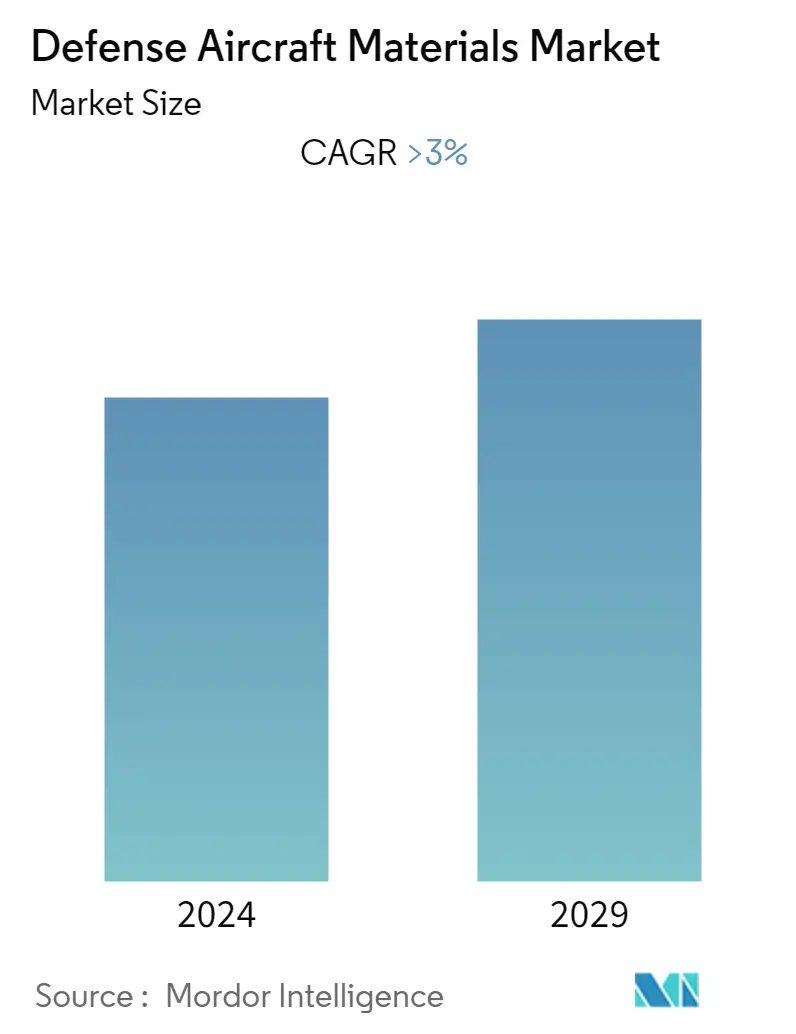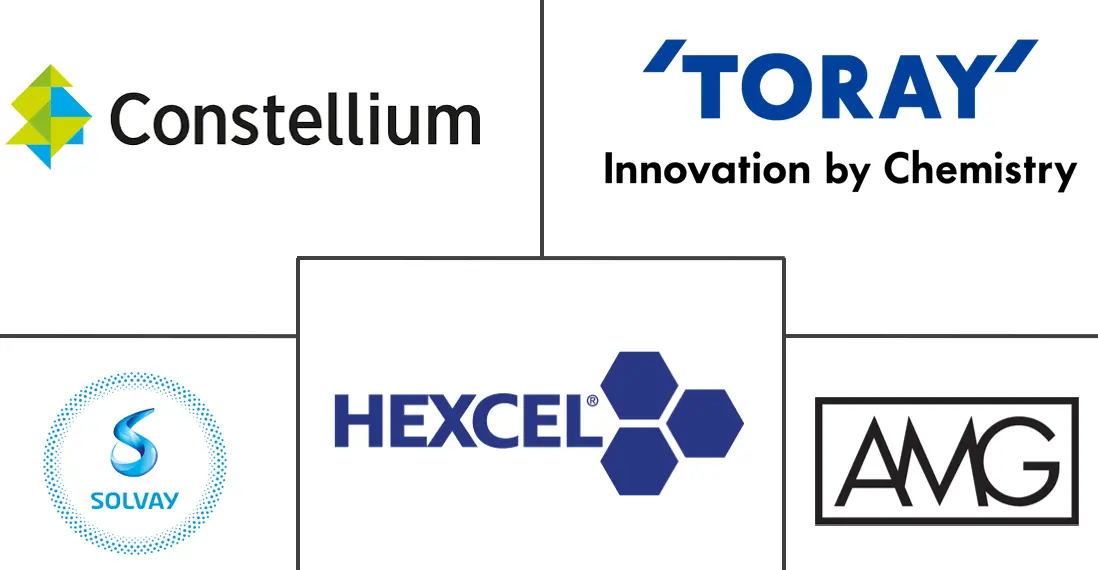Market Size of Defense Aircraft Materials Industry

| Study Period | 2019 - 2029 |
| Base Year For Estimation | 2023 |
| CAGR | > 3.00 % |
| Fastest Growing Market | Asia Pacific |
| Largest Market | North America |
| Market Concentration | Medium |
Major Players
*Disclaimer: Major Players sorted in no particular order |
Defense Aircraft Materials Market Analysis
The defense aircraft materials market is anticipated to register a CAGR of over 3% during the forecast period (2022 - 2031).
The COVID-19 pandemic had a slight impact on the Defense Aircraft Materials Market. For a minor part of 2020, the global lockdown and social distancing norms have led to severe supply chain constraints and a shortage of raw materials across the world. With the gradual relaxation of lockdown and the reduced impact of the pandemic, the supply chain of the materials was restored, and production rates started coming back to normal.
On the other hand, the defense spending and the budgets allocated towards aircraft procurement continued to increase in 2020 and 2021, despite the impact of the pandemic. The growing military conflicts between different countries and the rising demand for military aircraft among major countries are driving the demand for aircraft materials used in various aircraft across the world.
Emerging fabrication technologies and manufacturing processes are envisioned to improve the current properties of the military aircraft materials and foster the impetus for developing new alloys for manufacturing high-performing aircraft parts and airframe structures.
Defense Aircraft Materials Industry Segmentation
A modern military aircraft is composed of several metal alloys and composite structures joined to create the specific structural profile of the airframe and other constituent parts and components that fulfill the specified operational requirements of the aircraft. The market is segmented based on aircraft type into combat and non-combat. The market is also segmented by material type into aluminum alloys, steel, titanium alloys, and composites. The report also covers the market sizes and forecasts for the market in major countries across different regions. The market sizing and forecasts have been provided in value (USD million).
| Aircraft Type | |
| Combat | |
| Non-combat |
| Material Type | |
| Aluminum Alloys | |
| Steel | |
| Titanium Alloys | |
| Composites |
| Geography | |||||||
| |||||||
| |||||||
| |||||||
| |||||||
|
Defense Aircraft Materials Market Size Summary
The defense aircraft materials market is poised for steady growth, driven by increasing defense budgets and the rising demand for military aircraft globally. Despite the initial disruptions caused by the COVID-19 pandemic, which affected supply chains and raw material availability, the market has rebounded as production rates normalized. The ongoing military conflicts and the strategic focus on developing advanced combat aircraft, such as the fifth and sixth-generation models, are significant factors propelling the demand for specialized materials. Countries like the United States, China, and Japan are heavily investing in next-generation aircraft, with a particular emphasis on lightweight and durable composite materials to enhance performance and resilience. This trend is further supported by emerging fabrication technologies that promise to improve the properties of military aircraft materials, fostering innovation in alloys and manufacturing processes.
North America currently leads the defense aircraft materials market, largely due to the United States' substantial military procurement plans and its position as the world's largest military spender. The region's dominance is expected to continue, supported by ongoing research and development in composite materials aimed at producing lightweight and efficient aircraft components. Strategic collaborations and partnerships among key industry players, such as AMG Advanced Metallurgical Group N.V., Solvay SA, and Hexcel Corporation, are enhancing the supply chain's robustness and innovation capacity. While the market remains consolidated due to stringent regulatory policies, the focus on indigenous production and localization of supply chains is likely to encourage new entrants. Investments in research centers and agreements to develop advanced composite materials, as seen in initiatives by companies like Daher and Hindustan Aeronautics Limited, underscore the industry's commitment to meeting the evolving demands of military aviation.
Defense Aircraft Materials Market Size - Table of Contents
-
1. MARKET DYNAMICS
-
1.1 Market Overview
-
1.2 Market Drivers
-
1.3 Market Restraints
-
1.4 Porter's Five Forces Analysis
-
1.4.1 Threat of New Entrants
-
1.4.2 Bargaining Power of Buyers/Consumers
-
1.4.3 Bargaining Power of Suppliers
-
1.4.4 Threat of Substitute Products
-
1.4.5 Intensity of Competitive Rivalry
-
-
-
2. MARKET SEGMENTATION (Market Size and Forecast by Value - USD million, 2018 - 2027)
-
2.1 Aircraft Type
-
2.1.1 Combat
-
2.1.2 Non-combat
-
-
2.2 Material Type
-
2.2.1 Aluminum Alloys
-
2.2.2 Steel
-
2.2.3 Titanium Alloys
-
2.2.4 Composites
-
-
2.3 Geography
-
2.3.1 North America
-
2.3.1.1 United States
-
2.3.1.2 Canada
-
-
2.3.2 Europe
-
2.3.2.1 United Kingdom
-
2.3.2.2 Germany
-
2.3.2.3 France
-
2.3.2.4 Rest of Europe
-
-
2.3.3 Asia-Pacific
-
2.3.3.1 China
-
2.3.3.2 India
-
2.3.3.3 Japan
-
2.3.3.4 South Korea
-
2.3.3.5 Rest of Asia-Pacific
-
-
2.3.4 Latin America
-
2.3.4.1 Brazil
-
2.3.4.2 Rest of Latin America
-
-
2.3.5 Middle-East and Africa
-
2.3.5.1 Saudi Arabia
-
2.3.5.2 United Arab Emirates
-
2.3.5.3 Turkey
-
2.3.5.4 Rest of Middle-East and Africa
-
-
-
Defense Aircraft Materials Market Size FAQs
What is the current Defense Aircraft Materials Market size?
The Defense Aircraft Materials Market is projected to register a CAGR of greater than 3% during the forecast period (2024-2029)
Who are the key players in Defense Aircraft Materials Market?
AMG Advanced Metallurgical Group N.V., Solvay SA, Constellium SE, Hexcel Corporation and Toray Industries, Inc. are the major companies operating in the Defense Aircraft Materials Market.

